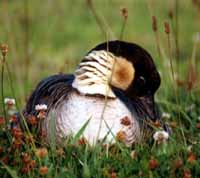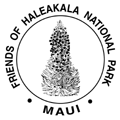Issues
Advanced
Technology Solar Telescope Project
"Science & Sacredness" by Valerie Monson
Published in The
Maui News - 4/2/06
FHNP POSITION STATEMENT
The Friends of Haleakala National Park
strongly oppose locating the Advanced Technology Solar Telescope
Project on Haleakala.
The entire mountain of Haleakala is a visual,
cultural, biological and geological resource that must continue
to be recognized as being of great significance and vital to
our visitors, to our local residents and to our economy.
One of the missions of the Friends of
Haleakala National Park is to preserve Haleakala’s unique
ecosystems, scenic character and associated Hawaiian culture
and spiritual resources.
This project is so huge and intrusive
it will adversely change Haleakala forever, causing irrevocable
loss of natural, cultural and scenic resources.
COMMENT OF FRIENDS OF HALEAKALA NATIONAL PARK
to the Advanced Technology Solar Telescope Project of the National
Science Foundation and the National Solar Observatory, dated
August 9, 2005.
Link to Kila Kila O Haleakala an opposition organization
|
Aliens
Haleakala National Park is one of the most threatened parks within the National Park System. It has more threatened and endangered species than any other national park in the U.S. The primary threat to Haleakala National Park is from alien species (such as non-native plants and animals that do not naturally occur in Hawaii). Alien species threats of great concern include Miconia, axis deer, feral cats, Western yellowjackets, and various ants. The most effective and economical way of dealing with destructive aliens is to prevent their introduction.
|

Photo by Christa Matthews
|
|
Endangered
Species
WHY ARE SPECIES ENDANGERED?
When there are only a small number of individuals of a species left, or when all of a species exists only in one small geographic location, such species are considered to be endangered - endangered with becoming extinct. When this happens, people enact laws to protect the species and try to find out why the species has become so reduced in numbers. There are three major reasons why a species becomes endangered.
1. Hunting for Commercial Gain
The numbers of some species have been severely reduced, not because their food source or habitat has been reduced, but because they have commercial value and people have killed large numbers of them to eat, or to make money with them. This is the reason why our Green Sea Turtle is endangered. This is also one of the reasons why our State bird, the Nene, became endangered. Originally, nene were on multiple Hawaiian islands, the first people of these islands ate nene, then two hundred years ago, with still thousands and thousands of Nene on the island of Hawaii, people started killing them with modern weapons to sell for meat.
2. Introduced Predators and Disease
In Hawaii since it is so isolated from anywhere else, the native species of animals and plants evolved without many kinds of predators or diseases. So, when foreign diseases and predators were introduced, the native species did not have any defense against them.
Mongooses, rats, cats, and pigs harass and eat native birds and their eggs and young. Diseases brought in with introduced, non-native birds, and spread largely by mosquitos, certainly have contributed greatly to the decline and extinction of many of our native forest birds. Introduced birds also compete with our native birds for food and nesting sites.
3. Reduction of Food or Habitat
 All living things interact with their environment. Each species interacts with its environment in its own special way. Some species have very specific needs-like our Palila, a forest bird which eats only green Mamane seed pods and insects associated with the mamane; or the 'Ihi'ihi-lau-a-kea a special fern of dry areas,which only lives in the temporary wet areas produced by wintertime (Kona) storms . These are called environmental specialists. Other species, called generalists, can live just about anywhere and eat anything. Common generalists are pigs, rats and mice and the myna bird, which eats almost anything other birds eat, including fruit, vegetables, and insects.
All living things interact with their environment. Each species interacts with its environment in its own special way. Some species have very specific needs-like our Palila, a forest bird which eats only green Mamane seed pods and insects associated with the mamane; or the 'Ihi'ihi-lau-a-kea a special fern of dry areas,which only lives in the temporary wet areas produced by wintertime (Kona) storms . These are called environmental specialists. Other species, called generalists, can live just about anywhere and eat anything. Common generalists are pigs, rats and mice and the myna bird, which eats almost anything other birds eat, including fruit, vegetables, and insects.
In contrast, most endangered species still living in the present are habitat or food specialists. There are very few places where they can live or very few things that they can eat. So when their food source is reduced (as by the grazing of mamane trees by sheep on Mauna Kea), or the areas where they can live are eliminated (like the filling in of marshes where the Hawaiian stilt lives), it becomes harder and harder for specialists to find food or a place to live.
Usually, more than one of these negative factors interact to cause a species to become endangered. That is what happened to the Nene. First, they were eaten and hunted until there were very few left; and their preferred lowland habitat was taken over for homes, farmland, and developments; and rats, cats, pigs and mongooses, which eat Nene eggs and young, were introduced, forcing them towards endangered species status and extinction.
YOU CAN HELP!
The State Department of Land and Natural Resources, Division of Forestry and Wildlife is working with other State and Federal agencies, like Haleakala National Park, to try to save Hawaii's endangered species. It is an enormous, and difficult task, AND this is your job as well as ours.
You can help preserve our endangered species by first of all learning about them and what their threats are, then acting for example by not releasing cage birds or pet cats and dogs or other pets into the wild, by keeping 'house' cats inside houses . Released birds and other animals may not survive, and if they do, they end up competing with our native species for habitat and food resources, or even by killing and eating them They can also often carry disease harmful to Hawaiian birds.
Do not harm or harass endangered animals or purchase meat or other products made from them. Do not bring illegal plants and animals into Hawaii. Things that seem harmless may turn out to be very destructive to island life. All of us must do what we can to help preserve these truly native Hawaiian species for ourselves and our children.
Friends
of Haleakala National Park
P.O. Box 322 ~
Makawao, HI 96768
(808) 264-4757 ~

